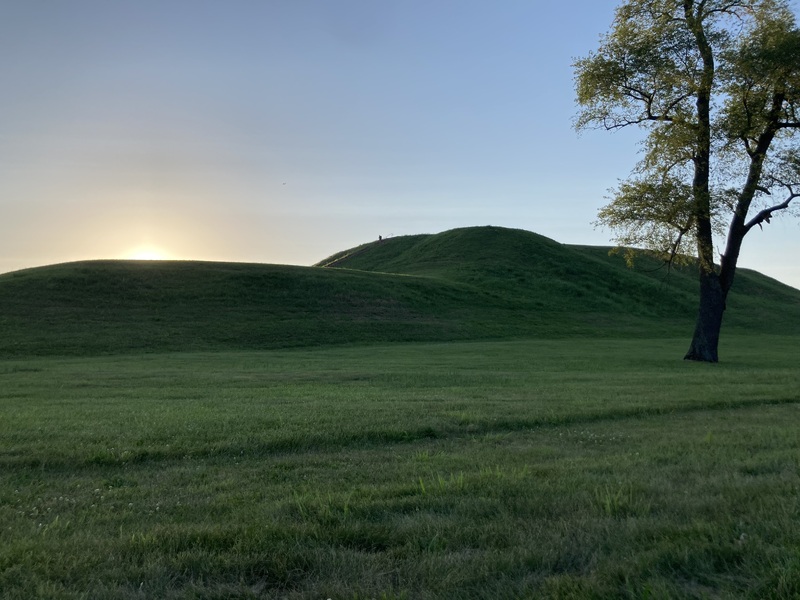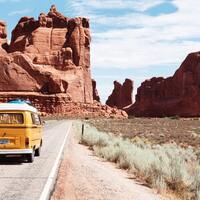Item
Covid-era Road Trip to Cahokia
Media
Title (Dublin Core)
Covid-era Road Trip to Cahokia
Disclaimer (Dublin Core)
DISCLAIMER: This item may have been submitted in response to a school assignment prompt. See Linked Data.
Description (Dublin Core)
As the cloud of Covid-19 began to dissipate in 2022, we made our annual summer pilgrimage from Arizona to Michigan, where much of my extended family still resides (and we can escape the heat of the Southwest). Due to lingering concerns over crowds and close contacts, we decided we would drive and make stops in Albuquerque, Oklahoma City, and St. Louis, where we ventured to a place I, the dorky World History teacher, had eagerly selected: Cahokia Mounds, the "Largest Pre-Columbian Site North of Mexico".
Approaching Cahokia, the scene might appear like a scatter plot of natural hills if they were not carefully mowed and kept generally free from trees and overgrowth. One can climb a staircase that ascends to the higher levels of Monk's Mound, the largest of several earthen pyramid-like structures in the area. I remember feeling conscious that it was the kind of climb that humans had made for several millennia, at Mesopotamian ziggurats, or similar Maya constructions at Chichen Itza, or the Acropolis at Athens-- up staircases, closer to the heavens, to honor deities or witness a royal wedding, or a coronation. I suppose my leashed golden doodle at my side and my chatterbox children following me injected distractions from the historical fantasies... Maybe I'm romanticizing this climb in my own memory.
Yet, the view of urban St. Louis from the top of Monk's Mound is beautiful, and one feels the transience of human endeavors-- the rise and fall of cities and civilizations. This particular hill I stood atop was, one-thousand years prior, an epicenter of socioeconomics in North America. Tens of thousands of people resided in the area, and perhaps hundreds of thousands visited seasonally from as far afield as the Gulf Coast to the south and the Great Lakes to the north, to witness and partake in rituals, celebrations, and social and economic exchanges. These mounds, constructed entirely by humans without draft animals, once held up large structures and were heavily populated for special events. They are now mostly barren and lonely, an occasional visitor climbing the steps for physical exercise or an exercise in perspective.
Though Cahokia's peak and decline as a site occurred well before the Columbian Exchange and arrival of Eurasian diseases, the barren hills and surrounding areas (and the isolating existence of the pandemic we were experiencing) made me think of the general decline and displacement of indigenous people. We were experiencing, in 2022, a pandemic that caused isolation, debilitation, distress, trauma, and occasionally death... Yet earlier epidemics were an absolute apocalypse for indigenous people throughout the Americas, often emptying entire regions of people well before the arrival of explorers, colonizers, and settlers.
To stand atop Monk's Mound, and to survey the urban sprawl of St. Louis in the distance, is to experience, spatially, tremendous change over time. My single life will hopefully last a few decades longer, and making this climb with my own children gave me a joyful sense of legacy and time beyond my own existence. For a few quiet moments at the top, however, I felt alone and small, a tourist under the weight of the distant past.
Approaching Cahokia, the scene might appear like a scatter plot of natural hills if they were not carefully mowed and kept generally free from trees and overgrowth. One can climb a staircase that ascends to the higher levels of Monk's Mound, the largest of several earthen pyramid-like structures in the area. I remember feeling conscious that it was the kind of climb that humans had made for several millennia, at Mesopotamian ziggurats, or similar Maya constructions at Chichen Itza, or the Acropolis at Athens-- up staircases, closer to the heavens, to honor deities or witness a royal wedding, or a coronation. I suppose my leashed golden doodle at my side and my chatterbox children following me injected distractions from the historical fantasies... Maybe I'm romanticizing this climb in my own memory.
Yet, the view of urban St. Louis from the top of Monk's Mound is beautiful, and one feels the transience of human endeavors-- the rise and fall of cities and civilizations. This particular hill I stood atop was, one-thousand years prior, an epicenter of socioeconomics in North America. Tens of thousands of people resided in the area, and perhaps hundreds of thousands visited seasonally from as far afield as the Gulf Coast to the south and the Great Lakes to the north, to witness and partake in rituals, celebrations, and social and economic exchanges. These mounds, constructed entirely by humans without draft animals, once held up large structures and were heavily populated for special events. They are now mostly barren and lonely, an occasional visitor climbing the steps for physical exercise or an exercise in perspective.
Though Cahokia's peak and decline as a site occurred well before the Columbian Exchange and arrival of Eurasian diseases, the barren hills and surrounding areas (and the isolating existence of the pandemic we were experiencing) made me think of the general decline and displacement of indigenous people. We were experiencing, in 2022, a pandemic that caused isolation, debilitation, distress, trauma, and occasionally death... Yet earlier epidemics were an absolute apocalypse for indigenous people throughout the Americas, often emptying entire regions of people well before the arrival of explorers, colonizers, and settlers.
To stand atop Monk's Mound, and to survey the urban sprawl of St. Louis in the distance, is to experience, spatially, tremendous change over time. My single life will hopefully last a few decades longer, and making this climb with my own children gave me a joyful sense of legacy and time beyond my own existence. For a few quiet moments at the top, however, I felt alone and small, a tourist under the weight of the distant past.
Date (Dublin Core)
Creator (Dublin Core)
Contributor (Dublin Core)
Event Identifier (Dublin Core)
Partner (Dublin Core)
Type (Dublin Core)
Photograph
Video
Link (Bibliographic Ontology)
Controlled Vocabulary (Dublin Core)
Curator's Tags (Omeka Classic)
Contributor's Tags (a true folksonomy) (Friend of a Friend)
Linked Data (Dublin Core)
Date Submitted (Dublin Core)
10/30/2024
Date Modified (Dublin Core)
10/31/2024
Date Created (Dublin Core)
06/22/2022
Item sets
This item was submitted on October 30, 2024 by Brian Holstrom using the form “Share Your Story” on the site “A Journal of the Plague Year”: http://mail.covid-19archive.org/s/archive
Click here to view the collected data.

